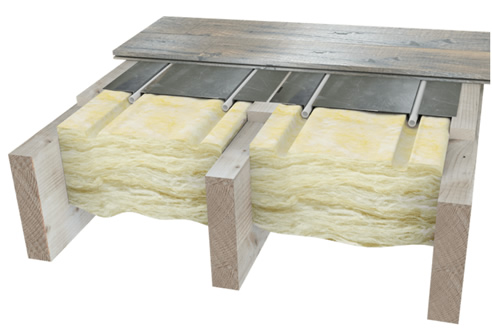Timber Joist Underfloor Heating from dPP Hydronic Heating

dPP Hydronic Heating are proud to offer Timber joist hydronic underfloor heating, which is now an option when the sub floor is timber by using heat emission plates. The heat emission plate conducts the heat energy from the hot water pipe that is laid within it, and this turns the whole floor into a radiant heater producing that amazingly comfortable warm home that hydronic floor heating is known for. It is an ideal heating solution for heating large open living areas such as kitchens, living and dining areas as well as bathrooms that are built on timber joists.
What is Heat Emission Plate?
Heat emission plate is an alluminium panel that can be installed along timber joist so that you can have hydronic heated floors with a timber sub floor. It is where the pipes that carry the heated water are laid along the groove within a heat emission panel. The pipes are laid 200mm apart in a snake like pattern to and from the manifold in 100m lengths. Each circuit covers around 20 square metres of floor space.
Our multi-layered specialist pvc pipes are 16mm Uponor Pex Pipe, made in Germany and inserted directly into the heat emission plate, and the sheet flooring is installed over the top. When in operation the floor heating thermostat will call for hot water from the boiler. A hydronic heating boiler will heat the water and pump it through the pipe at 50°C transferring its heat into the heat emission plate, this heat then radiates through the home similar to how a brick wall radiates heat after the sun goes down on a summers day.

Recommended Floor Coverings
The most suitable floor finishes for heat emission plate are engineered board or tiles. This is because they are all great conductors of the heat energy created from the hot water in the hydronic heating system. We do not recommend natural timbers or glued flooring as the heat from the heated slab can effects them. Carpet is an option but it will take longer to heat a room. Generally when you have carpet you would include radiator.
How long does it take to heat?
It takes around 8 - 12 hours for in heat emission plate to warm your home. It is designed to heat the space above it by transferring the heat energy in the water, across the plates and into the room above. It is a set and forget system, in that it is turned on at the start of the cold season and off at the end. If you require more control over your heating and you have a timber joist floor then you would consider radiator panels instead.
Can it leak after installation?
The only way for the pipe itself to leak is if it is punctured which is highly unlikely once installed. A 2013 study has also shown that PVC pipe is expected to last in excess of 100 years. The pipe is run in continuous circuits back to the manifold with no connections under the floor. Once the pipe is laid our technician will pressurise it to 10 bar to check for any leaks and to make a puncture during construction highly visible so that if it should be punctured it will be replaced. The operating pressure is only 1 bar, so we are testing the pipe at 10 times its running pressure.

|






 Narrow Panel Radiators - Vasco Flatline
Narrow Panel Radiators - Vasco Flatline Colour Panel Radiators - Zaros from dPP
Colour Panel Radiators - Zaros from dPP Hydronic Heating Trenches & Grills by
Hydronic Heating Trenches & Grills by Sustainable Heritage-look Radiators from
Sustainable Heritage-look Radiators from Vintage Tubular Radiators - Ritmo from
Vintage Tubular Radiators - Ritmo from Ultra-thin Designer Radiators - Oni from
Ultra-thin Designer Radiators - Oni from Designer Radiators With Towel Rails from
Designer Radiators With Towel Rails from NIVA Designer Radiators with Accessories
NIVA Designer Radiators with Accessories Designer Vertical Radiators - Piano
Designer Vertical Radiators - Piano Aluminium Designer Radiators from dPP
Aluminium Designer Radiators from dPP Sustainable Underfloor Heating Melbourne
Sustainable Underfloor Heating Melbourne Coloured Designer Radiator Panels from
Coloured Designer Radiator Panels from Hydronic Heating Specialists - dPP
Hydronic Heating Specialists - dPP Bosch Boilers Now Available from dPP
Bosch Boilers Now Available from dPP In-slab Heating for Brighton Residence
In-slab Heating for Brighton Residence Hydronic Panel Heaters & Towel Rails for
Hydronic Panel Heaters & Towel Rails for Designer Heating Panels Virtual Showroom
Designer Heating Panels Virtual Showroom Stylish Electric Radiator Panels from
Stylish Electric Radiator Panels from Hydronic Heating Install for AFL Star
Hydronic Heating Install for AFL Star Designer Hydronic Radiators - 360 from
Designer Hydronic Radiators - 360 from
